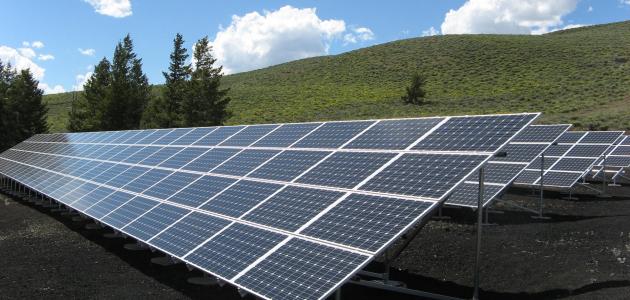solar energy
Solar energy is one of the most abundant renewable energy sources in the world. It is solar radiation that can be used for several things, the most important of which are: producing chemical reactions, producing heat, and generating electricity. In addition, solar energy is spread throughout the world. It is considered a clean source that does not cause pollution, so if it is exploited and utilized appropriately, it will meet a large percentage of the world’s energy needs in the future.
The potential of solar energy as an energy source
It is possible to take advantage of sunlight and collect it to transform it into another form of energy, such as: electrical energy, using modern technology and techniques. Therefore, establishing projects to generate solar energy depends on the amount of solar rays that fall on a specific area to determine the potential of solar energy in it. It has been found The amount of rays reaching a specific area varies depending on the geographical location of the area, its general climate, and the length of the day in this area.
In order to determine the potential of solar energy as an important energy resource in a particular area, the amount of rays falling on this area is measured at different times of the year, then compared with other areas located at the same latitude, and the data resulting from measuring the amount of rays falling is expressed in kilowatts. per hour per square meter (kilowatt*hour/square meter). If the solar energy potential qualifies for establishing solar energy generation projects, it is established in this area.
Read also:water in natureSolar energy generation
To generate solar energy and convert it into a form that can be used, some technologies must be available that collect photons resulting from solar radiation and work to convert them into electricity or heat. These technologies include:
Photovoltaic arrays
Photovoltaic arrays (in English: Photovoltaic Arrays) work to convert solar energy into electrical energy through the photoelectric conversion process using photovoltaic cells. This array is a number of photovoltaic cells connected together using metallic materials, and connected to a frame that supports them, which produces more energy than the energy produced by a solar cell. One, and each photovoltaic cell is composed primarily of processed silicon, which is manufactured in a way that allows electricity to be transmitted through it, and the array is connected to the rest of the solar energy generation system.
Reflectors
The inverter is the part responsible for converting solar energy into a form that can be used, as the amount and type of energy produced by photovoltaic cells suffer from problems, as they produce a continuous electrical current, and this type of current is not suitable for all devices, and the amount of energy that What the cell produces is unstable due to the difference in the amount of rays falling on it. The inverter addresses these problems by converting the direct current into an alternating current that is suitable for all devices. It also addresses the problem of the unstable amount of energy and works to produce a fixed amount of energy. It also ensures voltage stability for the system.
Read also:How to search for goldPhotoelectric control array
The photovoltaic array controller (in English: Photovoltaic Array Controller) works to increase the efficiency of the solar energy generation system, by tracking the sun's rays using light sensors, and moving the photovoltaic array towards the sun's rays to collect the largest amount of sunlight using control units, and after producing energy, it can be used to operate hardware or other matters by installing this system with the required hardware.
Solar energy storage
When generating solar energy in order to convert it into another form, it faces the problem of being unable to generate and produce energy in the evening, so it was necessary to have methods to store this energy, and these methods include:
- Optical energy storage: Batteries are used within the system to store electricity when charging them. A basic requirement for these batteries is that they are rechargeable, as they store energy during the day, to be used in the evening, and then they are recharged during the day.
- Thermal energy storage: This type is specific to water heating systems that convert solar energy into thermal energy, as these systems contain a simplified storage system in the form of solar energy collectors, and when needed, hot water moves from the storage collectors to the desired location.
Pros and cons of solar energy
Solar energy is considered one of the most important sources of energy, and like other forms of energy, it has a set of pros and cons.
Read also:Dead Sea mud and its benefitsAdvantages of solar energy
Solar energy has a number of advantages that encourage reliance on and exploitation of it. The most important of these advantages are:
- A renewable source of energy, as sunlight is inexhaustible and always available in all parts of the world.
- It can be used for several applications, such as: producing electricity and heat, desalinating and distilling water, especially in places where clean water is not available, and it can be used to supply energy to satellites, and other uses.
- Low maintenance costs. Despite the high construction costs, its maintenance is available and cheap, and by maintaining it and keeping it clean, it can last for several years.
- The continuous development in the field of solar energy technology, especially nanotechnology and quantum physics, which seeks to improve the efficiency and effectiveness of solar energy generation systems in the future.
Disadvantages of solar energy
Despite the positives that solar energy has, there are a number of negatives to it, including:
- Weather changes, as the weather difference in summer and winter reduces the percentage of benefit from it.
- Not being able to benefit from it in the evening, therefore it is necessary to have a device that stores energy such as a battery.
- Large areas must be provided to collect the largest amount of solar energy. So that solar energy is optimally utilized.
- Its high cost because it requires techniques and technology to develop solar energy generation systems, as generating electricity from solar energy generation is five times greater than generating electricity using fossil fuels.









